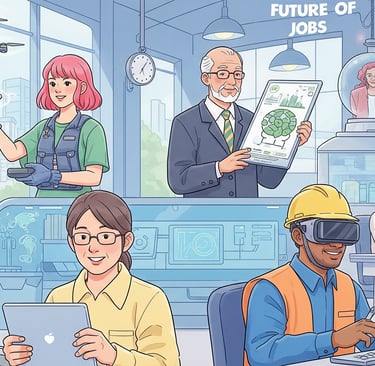The Future of Jobs: Navigating Technological Disruption with Skill and Innovation
Discover how new-age technologies like AI, Robotics and 3D printing are reshaping jobs in this insightful article. Learn key skills like creativity and adaptability to thrive in the future job market, with opportunities in gaming and innovation. Stay ahead with continuous learning!
TECHNOLOGYJOBSINNOVATION
Suraj Prasad
6/30/20254 min read


In the annals of human history, the nature of work has undergone profound transformations, each era marked by its own challenges and opportunities. In pre-industrial societies, unemployment as we understand it today did not exist. People led subsistence lives, toiling in their own fields or those of others, or working as artisans crafting goods. In times of conflict, they became combatants. The rise of mercantilism, followed by the Industrial Revolution, birthed a middle class, which was further strengthened by mass manufacturing and the Information Technology boom. Today, we stand at the threshold of another monumental shift, driven by Artificial Intelligence (AI), robotics, and 3D printing technologies poised to disrupt traditional employment paradigms. Yet, this era also heralds unprecedented opportunities for innovation and skill development. This article explores the future of jobs, offering insights into the skills and mindsets necessary to thrive amid technological upheaval.
Historical Context and the Current Landscape
To grasp the future of work, we must first reflect on its past. Pre-industrial societies were agrarian, with labor tied directly to survival. The Industrial Revolution introduced mechanized production, creating factory jobs and fostering a growing middle class. The late 20th century ushered in the Information Age, where knowledge workers became pivotal to global economies. Each of these shifts displaced certain roles while giving rise to new ones, a pattern that persists today.
In the modern era, AI, robotics, and automation are set to redefine employment. Routine tasks, from assembly lines to administrative duties, are increasingly performed by machines, rendering some traditional skills obsolete. However, this technological evolution also paves the way for innovation, particularly in areas that demand human creativity, emotional intelligence, and adaptability qualities that machines have yet to master.
Skills for the Future: Beyond Automation
As we look ahead, the jobs most likely to endure will be those requiring distinctly human capabilities. Skills such as designing, product development, and soft skills including marketing, negotiation, and consulting will remain in high demand. These competencies involve complex problem-solving, creative thinking, and interpersonal engagement, areas where AI and robotics struggle to compete. Additionally, as robotics becomes more prevalent across industries, expertise in robotics engineering, programming, and maintenance will be increasingly sought after, offering a new frontier for technical professionals.
The story of Swami Vivekananda, a first-class graduate and erudite scholar in the late 1800s, serves as a poignant reminder of this principle. Despite his impressive credentials, he faced significant challenges in securing employment, highlighting a timeless truth: qualifications alone do not ensure success. Today, as in Vivekananda’s time, employability hinges on acquiring the right skills and adapting to shifting demands. Future-ready professionals must ask themselves critical questions: What value do I bring to my employer? How do I enhance their business in ways technology cannot? Are my skills flexible enough to evolve with new opportunities?
Innovation and Opportunity in the Age of AI and Robotics
While AI and robotics may diminish the relevance of certain technical skills, they also democratize access to tools that can fuel innovation. Software as a Service (SaaS) platforms, AI-driven technologies, and robotic systems enable individuals to create, automate, and market products with minimal resources. The entertainment and gaming industries, often overlooked, are emerging as promising fields for employment, with robotics playing a transformative role. In film, for example, robotic camera systems allow for precise, complex shots, while animatronics bring lifelike creatures to the screen, as seen in Jurassic Park and Transformers. Robots also enhance safety by handling dangerous tasks like pyrotechnics, reducing risks for stunt performers and crew. This integration of robotics not only elevates creative output but also creates jobs for technicians and engineers skilled in operating these systems.
Beyond entertainment, robotics is revolutionizing public services. In cities like Bangalore and Hyderabad, robots can be deployed to clean lakes and water bodies, efficiently removing debris and pollutants. This not only supports environmental sustainability but also generates demand for professionals who can design, program, and maintain these machines. Robotics is also enhancing surveillance and governance, with applications ranging from traffic management to disaster response, further expanding career opportunities in these fields.
A personal anecdote underscores this shift. As a young student, I spent countless hours playing video games, often cautioned that it was a waste of time. Years later, I reconsidered this perspective and recognized the potential of the entertainment industry. Unlike many sectors, gaming thrives on human imagination and creativity, attributes AI and robotics enhance but cannot replace. Inspired by this insight, I ventured into game development, honing skills in modeling, designing, coding, and scripting. Tools like Blender have empowered me to craft compelling digital content, illustrating the vast potential for innovation in this domain.
The Evolving Role of Engineers and Continuous Learning
The future of engineering is also transforming, with robotics at its core. A recent conversation with a mechanical engineering graduate revealed a shared vision: starting around 2025, engineering will demand a broader, more interdisciplinary skill set. The age of hyper-specialization may give way to a model where engineers are versatile problem-solvers, equipped to tackle diverse challenges. A mechanical engineer, for example, might benefit from understanding motors, digital signal processing, and robotics, while a computer engineer could gain an edge by mastering sensors, microcontrollers, and robotic systems.
This horizontal expansion of skills ensures long-term relevance in a dynamic job market. By studying case studies across industries and committing to lifelong learning, professionals can safeguard their careers against obsolescence. The lesson is clear: adaptability, a thirst for knowledge, and expertise in emerging fields like robotics are as vital as technical proficiency.
Conclusion: Preparing for Tomorrow’s Job Market
As we navigate the future of work, we must prioritize skills that withstand technological disruption. While AI, robotics, and automation will reshape the employment landscape, they also offer opportunities for those prepared to innovate and adapt. By cultivating expertise in design, product development, soft skills, and robotics, and by embracing continuous learning, individuals can position themselves at the forefront of the next employment frontier.
In the words of Swami Vivekananda, “Arise, awake, and stop not until the goal is reached.” For today’s workforce, the goal extends beyond securing a job: it is about thriving in an ever-changing world. By thinking flexibly, valuing innovation, and focusing on skills that machines cannot duplicate, we can transform the future of work into an era of opportunity, growth, and fulfilment.


Suraj Prasad
Engineer at Esko
